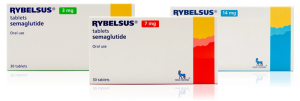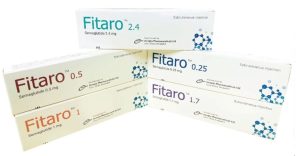Sorry, nothing in cart.
Semaglutide shades comparison to treat type 2 diabetes?
- By admin
- |
- General Blog
- |
In this blog, we will explore how diabetes develops, what diabetes is, and how to manage type 2 diabetes. Among the recent developments in diabetes therapy is Semaglutide, giving a full solution for type 2 diabetes control. This innovative treatment comes in two forms: oral tablets, known as Rybelsus, and injectables, like Ozempic, both containing the active ingredient semaglutide.
Definition of Diabetes
Diabetes is a condition where your body has difficulty managing the sugar in your blood. When you eat, your body turns food into glucose (sugar), which is used for energy. Normally, a hormone called insulin helps your cells absorb this sugar from the blood to use it for energy.
But in diabetes, there is a problem with insulin. Your body can’t make enough insulin, or it can’t use it properly. Thus, sugar stays in your blood, which can raise your blood sugar levels.
Diabetes is a serious medical condition that can lead to feelings of fatigue, extreme hunger, and other more serious problems over time. If you do not manage this disease, you can develop serious complications like vision problems, dementia, and kidney issues.
Diabetes can be classified into various categories, each with its own set of causes, symptoms, and treatment options. The main types of diabetes include:
- Type 1 Diabetes
- Type 2 Diabetes
- Gestational Diabetes
- Other Specific types of diabetes (Like, Monogenic Diabetes and Secondary Diabetes)
What is type 2 diabetes?
A chronic metabolic disorder known as type 2 diabetes is characterized by a deficiency of insulin and insulin resistance. When the body doesn’t react to insulin or doesn’t make enough insulin, blood sugar levels rise. This is called type 2 diabetes. If not properly managed, this can cause a range of complications. Insulin is produced by the pancreas and helps keep blood sugar steady.
Healthcare practitioners medication for the treatment of type 2 diabetes is only accessible via prescription. Although there are several drugs available for the control of diabetes, Semaglutide was the perfect choice to treat diabetes.
What is Semaglutide?
Semaglutide (SEM a GLOO tide) is an antidiabetic medication that belongs to the class of drugs known as GLP-1 receptor agonists. Semaglutide is used to treat Type 2 diabetes. The molecular formula for semaglutide, the active component in drugs such as Ozempic and Rybelsus, is C187H291N45O59. When people with type 2 diabetes follow a good diet and exercise plan, semaglutide can help lower their high blood sugar.
GLP-1 (glucagon-like peptide-1) is a hormone that plays a vital role in blood glucose regulation and appetite control. By activating the GLP-1 receptor, semaglutide helps in the management of type 2 diabetes and promotes weight loss.
GLP-1 agonists, such as semaglutide, which is contained in Ozempic, mimic the effects of the body’s natural hormone GLP-1. GLP-1 agonists can slow stomach emptying and reduce food intake, resulting in a decreased appetite and a sensation of fullness. This can lead to weight loss as a side effect, which is advantageous for people who are overweight or obese. It is vital to emphasize that weight loss is not the primary reason for these medications, but rather a potential good side effect for some people.
Although the primary indication for FDA approval of GLP-1 agonists like semaglutide (Ozempic) is the treatment of type 2 diabetes, these medications have been associated with weight loss as a side effect. This weight loss impact has sparked interest in taking these drugs for weight control, even though they are not labeled for weight loss.
Mechanism of Semaglutide:
A: GLP-1 Receptor Activation: Semaglutide activates GLP-1 receptors in the pancreas, caused to incresed insulin secretion in response to helps blood sugar levels.
B: Blood Glucose Regulation: By increasing insulin release and inhibiting glucagon secretion, Semaglutide helps to regulate blood sugar levels, reducing the risk of hyperglycemia (high blood sugar).
C: Appetite and Weight Control: Semaglutide affects appetite regulation and improves weight loss by delaying gastric emptying and increased felling of fullness, which can be benefical for people with type 2 diabetes who are overweight or obese.
Dual Benefits: Blood Sugar Control and Weight Loss
Blood Sugar Control:
Semaglutide belongs to a class of drugs known as GLP-1 agonists, specifically targeting the glucagon-like peptide-1.
It has the ability to bind to the GLP-1 receptor in the brain and enhance its activity, resulting in several positive effects downstream. For example, when this receptor is turned on, it can cause a rise in proteins known as “incretins,” which:
- Assist the body in generating insulin, precisely when it is required
- Minimize the excessive release of glucose (sugar) by the liver
- Reduce the speed of food digestion and emptying in the stomach.
- Suppresses appetite, leading to decreased food consumption
Because of this, it is an extremely useful drug for managing type 2 diabetes.
Weight Loss:
Semaglutide (Ozempic) lowers blood sugar, it also can help with weight loss. Semaglutide is not approved by the FDA for weight loss, but its often prescribed off-label for use. Semaglutide consistently improves blood sugar control and weight loss in persons with type 2 diabetes and obesity.
One of the best things about Semaglutide is that it can help you lose weight. Clinical tests have shown that people who take Ozempic lose more weight than people who take other diabetes medicines. Because it does two things at once, it is a unique and very helpful treatment choice. On the other hand, Semaglutide is not a magic bullet and should be used along with a healthy diet and exercise.
Visit:
Why is Semaglutide not prescribed for type 1 diabetes and diabetic ketoacidosis?
Semaglutide helps the body create more insulin and lower blood sugar, hence it is not utilized in diabetic ketoacidosis (DKA) or type 1 diabetes. In DKA, the body experiences a severe insulin shortage, resulting in dangerously high blood sugar levels and the production of ketones.
Using Semaglutide in this case may exacerbate the problem by further lowering insulin levels. Furthermore, Type 1 diabetes, the body does not produce any insulin. Treatments for type 1 diabetes focus on replacing the insulin that is missing rather than boosting its production or effectiveness. Thus treatments like Semaglutide that rely on the body’s ability to produce insulin are ineffective. As a result, Semaglutide is largely used to treat type 2 diabetes, in which the body continues to produce insulin but struggles to use it properly.
Pros and Cons of Semaglutide:
Pros:
- It effectively reduces blood sugar levels in type 2 diabetes.
- It promotes weight loss as a side effect.
- It reduces the risk of cardiovascular events.
- Appropriate dosing (once-weekly for Ozempic, once-daily oral medication for Rybelsus).
Cons:
- Side effects can include nausea, vomiting, and diarrhea.
- Injections may be inconvenient for some.
- Compared to some other diabetes medications.
- Not recommended for type 1 diabetes or diabetic ketoacidosis.
How Diabetes drug is a game changer for weight loss?
Diabetes drugs like semaglutide (Rybelsus, Ozempic) are game-changers for weight loss because they reduce blood sugar, make you feel full, and slow down digestion. This reduces food intake and calorie absorption, causing considerable weight reduction. Because they do two good things, they are useful for managing obesity, which often happens along with type 2 diabetes.
Semaglutide-based medicines have easy dosing schedules, with choices like injecting once a week (Ozempic) or taking tablets once a day (Rybelsus). This may help people stick with their treatment and reach their long-term weight control goals because it is so easy to use.
What are the risk factors for Type 2 diabetes?
- Are overweight or have obesity?
- Have prediabetes.
- Are 45 years or older.
- Have parents or siblings with type 2 diabetes
- Have Gestational Diabetes
- Inactive Lifestyle
- Unhealthy diet
- Are overweight or have obesity?
Important information on the proper use of semaglutide:
Novo Nordisk is a worldwide healthcare leader founded in 1923 and headquartered in Denmark. Our mission is to create change in the fight against major chronic diseases, built upon our heritage in diabetes.
Pills4cure primary goal is to provide patient safety and a great experience with our FDA-approved semaglutide medications.” The business is determined to continue promoting the proper use of Novo Nordisk’s FDA-approved medicines.”
The FLOW study (Semaglutide Effects on Cardiovascular Outcomes in People With Overweight or Obesity) found that semaglutide significantly reduced the risk of renal (kidney) disease-related events in people with type 2 diabetes and chronic kidney disease.
Comparative Overview: Ozempic and Rybelsus in Managing Diabetes
Semaglutide (Rybelsus and Ozempic) is prescribed to individuals with type 2 diabetes to help them control their blood glucose levels. Somehow, weight loss was minimized. Both medicine manufacturers, working, ingredients, uses, and side effects, all are the same.
Ozempic and Rybelsus have acquired regulatory approval in numerous countries, including the United States, United Kingdom, European Union, Canada, Australia, Japan, Scandinavian countries, and others, demonstrating their efficacy and safety. If you want to know more about Rybelsus and Ozempic, see in next blog.
The first type of medication is known as Rybelsus. Rybelsus is an anti-diabetic medicine used to treat type 2 diabetes. It can also be used to lose weight off-label. Rybelsus comes in the form of pills, which should be taken daily at the same time. After taking rybelsus, wait at least 30 minutes before eating, drinking, or taking any other medications.
The second option is injection, often known as Ozempic. Ozempic is used to treat type 2 diabetes and reduce weight loss as a side effect in some people, along with diet and exercise. Ozempic is administered subcutaneously, once every seven days, under the skin of the abdomen, thigh, or upper arm, as directed by your physician. It also reduces heart disease, and cardiovascular and renal (kidney) problems.
Let’s examine the differences between them so you can decide which medication is best for you.
| Rybelsus | Ozempic | |
| Administration: | Oral tablet form | Injection form |
| Active ingredient: | Semaglutide | Semaglutide |
| Manufacturer name: | Novo Nordisk | Novo Nordisk |
| Drug Class: | GLP-1 receptor agonists | GLP-1 receptor agonists |
| Mechanism of Action: | It works by activating GLP-1 receptors, leading to increased insulin secretion, decreased glucagon secretion, delayed gastric emptying, and reduced appetite. | Like Rybelsus, Ozempic activates GLP-1 receptors, leading to similar effects on insulin and glucagon secretion, gastric emptying, and appetite regulation. |
|
Efficacy: |
Effectiveness in reducing blood sugar levels and promoting weight loss. | Ozempic useful in improving glycemic control and promoting weight reduction. |
| Dosage: | Doses are: 3mg, 7mg, and 14mg | Doses are: 0.25mg, 0.5mg, and 1mg |
| Duration: | Once-daily tablet | Once-weekly subcutaneous injection |
| Where to Inject: | NO | Stomach, Thigh, Upper Arm |
| For weight loss: | Short term: Weeks to Months
Long-term: Months to Years |
Short term: First few weeks
Long-term: 4 to 6 weeks |
| Treatment: | Type 2 diabetes | Type 2 diabetes |
| Who can use: | Type 2 Diabetes
|
Type 2 Diabetes
Weight Management Cardiovascular Disease Renal Function |
| Image: |  |
 |
 English
English
 French
French  German
German